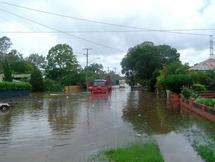Ancient El Nino clue to future floods

(PhysOrg.com) -- Dramatic climate swings behind both last year's Pakistan flooding and this year’s Queensland floods in Australia are likely to continue as the world gets warmer, scientists predict.
Researchers at the Universities of Oxford and Leeds have discovered that the El Niño Southern Oscillation (ENSO), the sloshing of the warmest waters on the planet from the West Pacific towards the East Pacific every 2-7 years, continued during the Earth’s last great warm period, the Pliocene.
Their results suggest that swings between the two climatic extremes, known as El Niño and La Niña, may even have occurred more frequently in the warmer past and may increase in frequency in the future. Extreme ENSO events cause droughts, forest fires and floods across much of the world as well as affecting fishery production.
Reporting in the journal Paleoceanography, the team of geochemists and climate modellers use the Pliocene as a past analogue and predictor of the workings of Earth’s future climate.
The Pliocene (which lasted from 5 to 3 million years ago) had carbon dioxide levels similar to the present day, with global mean temperatures about 2-3ºC higher, so it is a useful test-ground for climate research.
Lead Scientist Nick Scroxton from Oxford University's Department of Earth Sciences said: ‘We know from previous studies that the mean state of the Pacific during the warm Pliocene was similar to the climate patterns observed during a typical El Niño event that we see today.
‘However, until recently it was believed that a warmer Pacific would reduce the climate swings that cause the dramatic weather extremes throughout the region leading to a permanent state of El Niño. What we didn’t expect was that climatic variability would remain strong under these warmer conditions.’
The team combined experiments performed on the Met Office Hadley Centre climate model, HadCM3, with the analysis of the chemical composition of lots of individual shells of small organisms, known as foraminifera.
These were collected from a deep sea sediment core in the East Equatorial Pacific, and provided a record of temperature in the upper layer of the ocean through time. They discovered that the range of temperatures experienced by these organisms during the Pliocene, was higher than what would be expected from just the seasonal cycle.
The extra variation in temperature can be explained by the additional extreme temperature swings provided by the El Niño/La Niña system.
The authors say the agreement in findings from both ocean data and modelling leaves little doubt that ENSO will persist in a warmer world. Earlier this year a team from Japan studying corals from the same period showed climatic variability in the western Pacific on a similar scale to today, questioning the idea of a permanent El Niño during the Pliocene.
This new study goes further, showing that the oscillation is Pacific-wide, and is likely to be caused by the El Niño/La Niña. This suggests that our warmer future will continue to be dogged, maybe even more regularly, by extreme climatic events.
A report of the research, entitled ‘Persistent El Niño-Southern Oscillation variation during the Pliocene Epoch’, is published in the journal Paleoceanography.
Provided by Oxford University


















